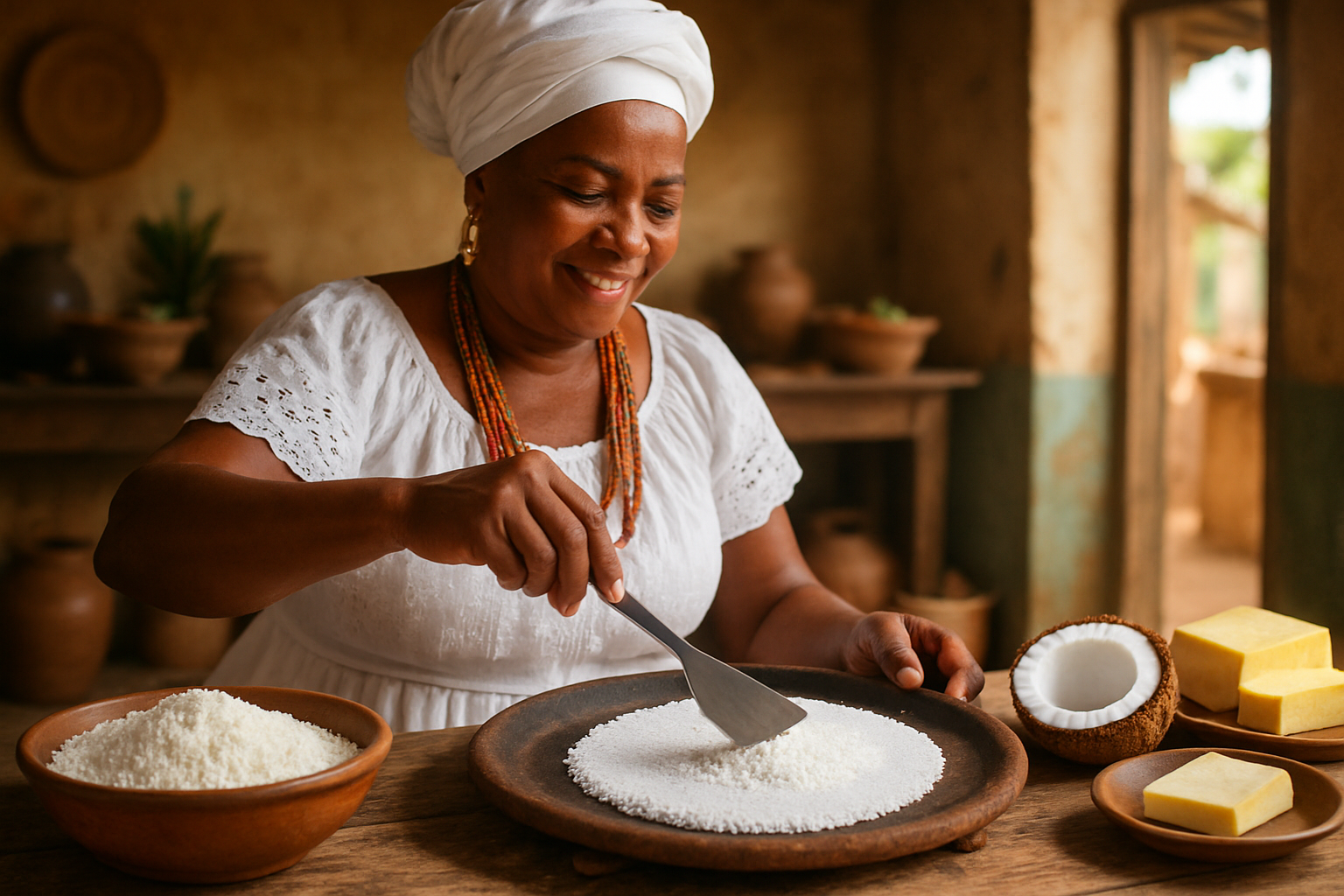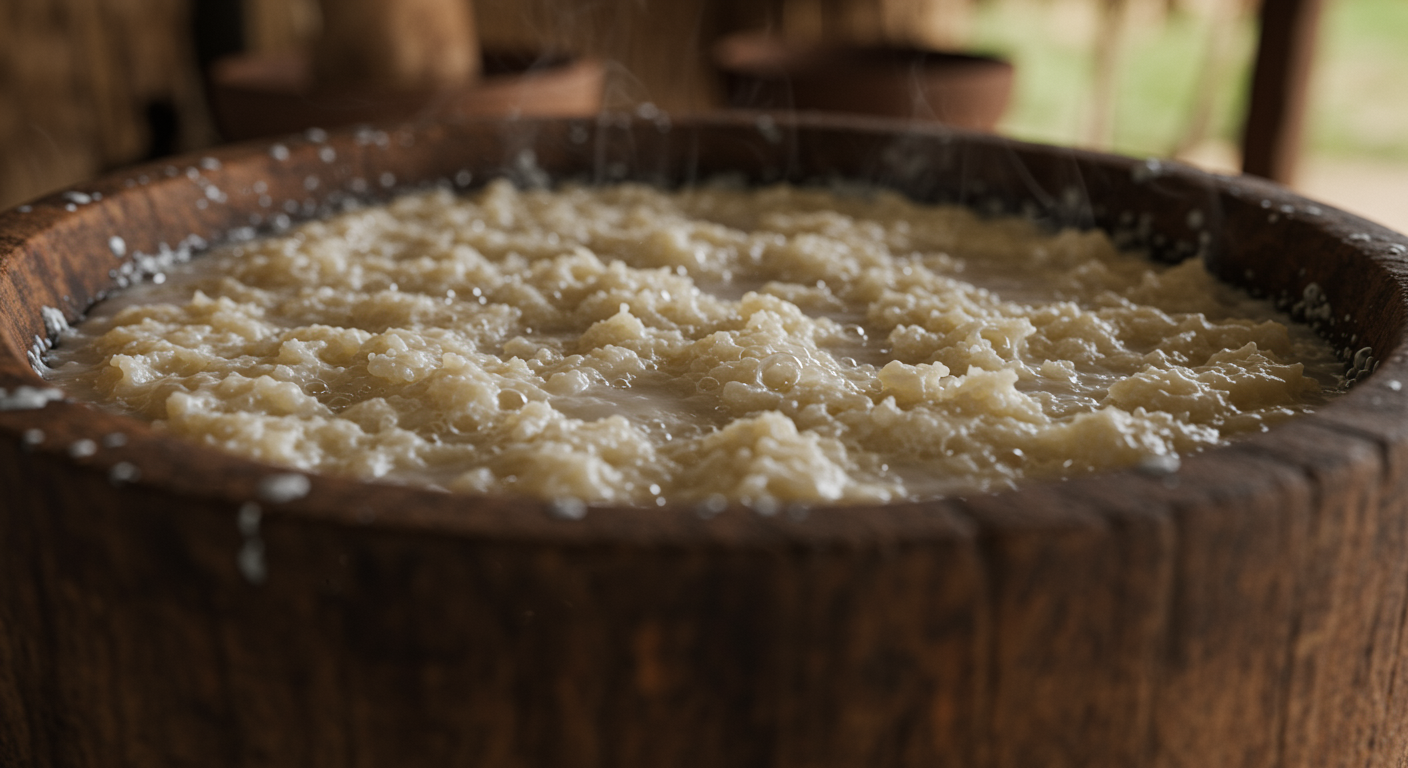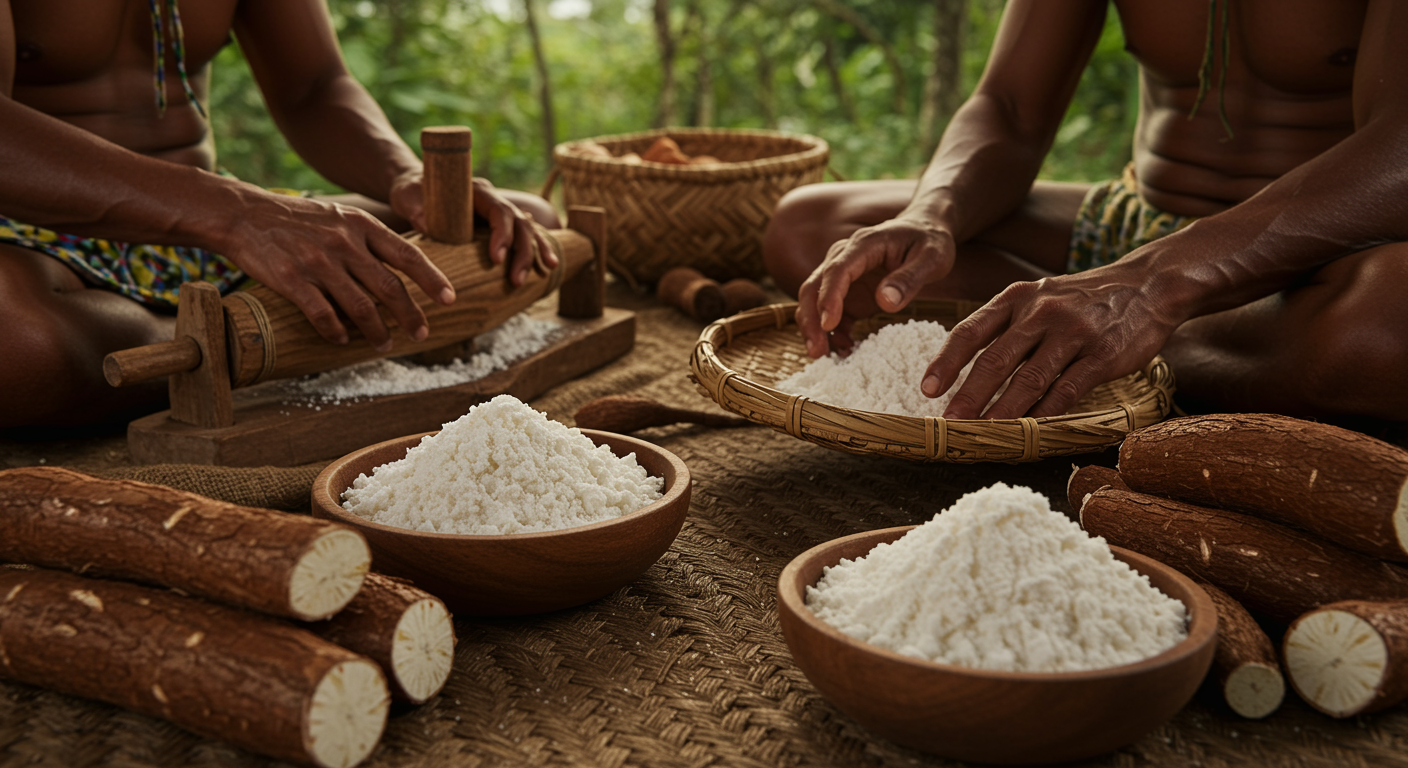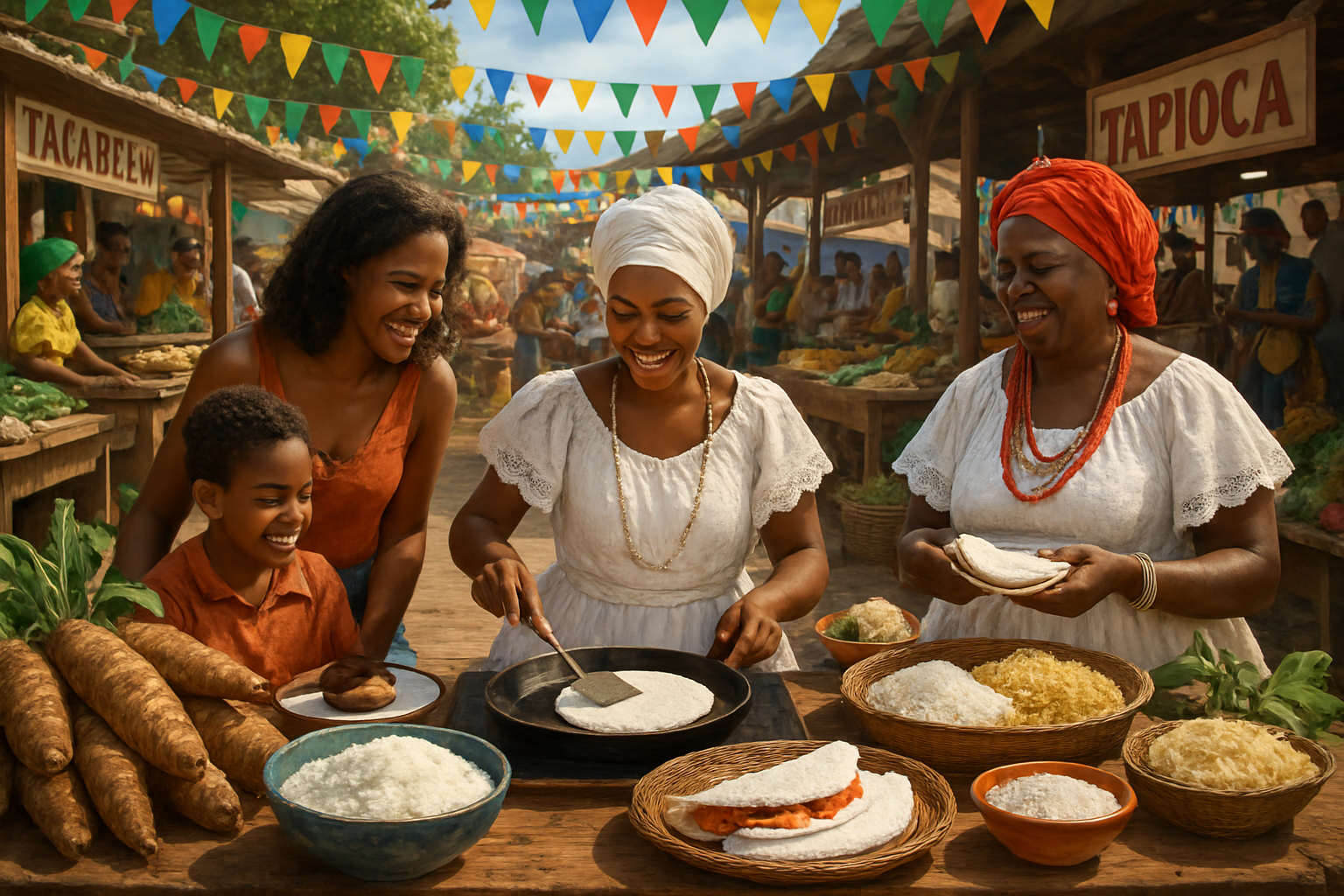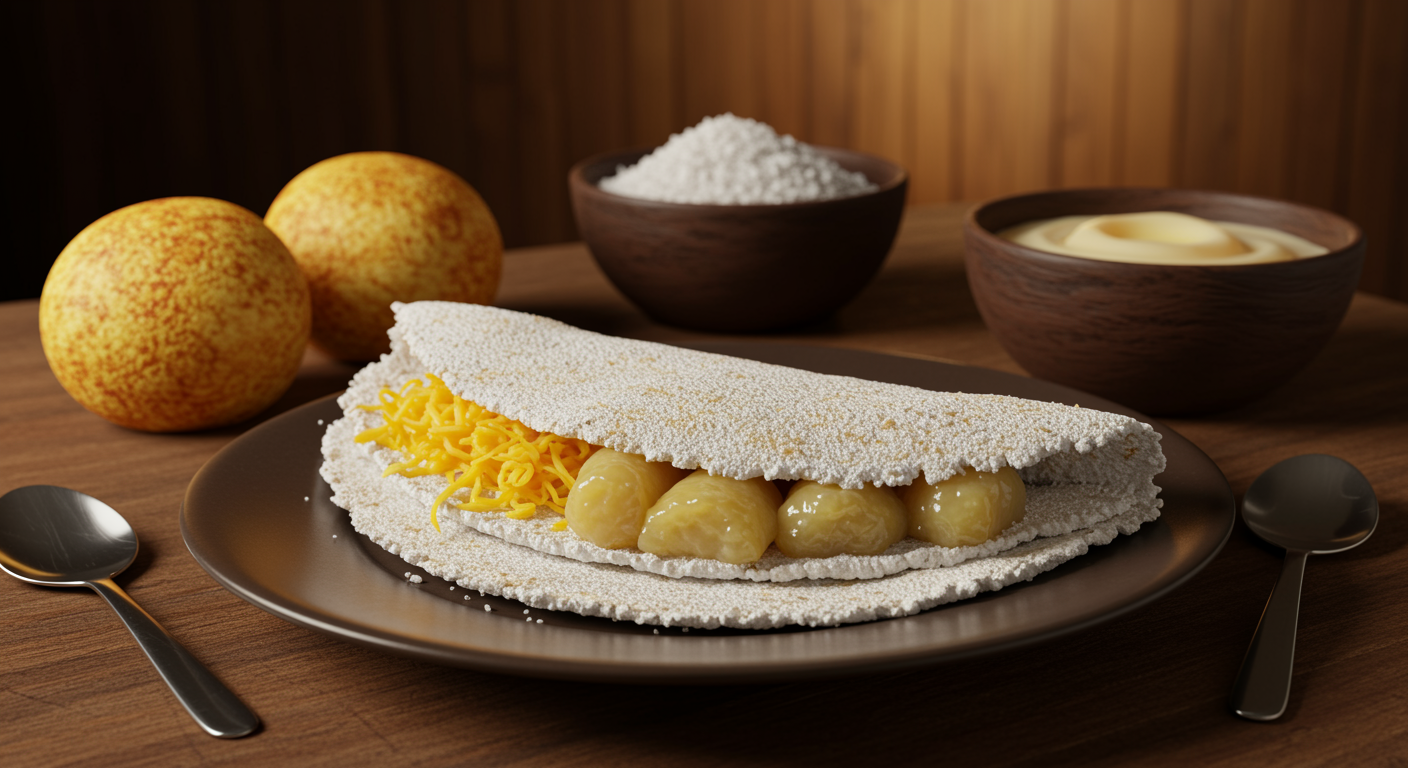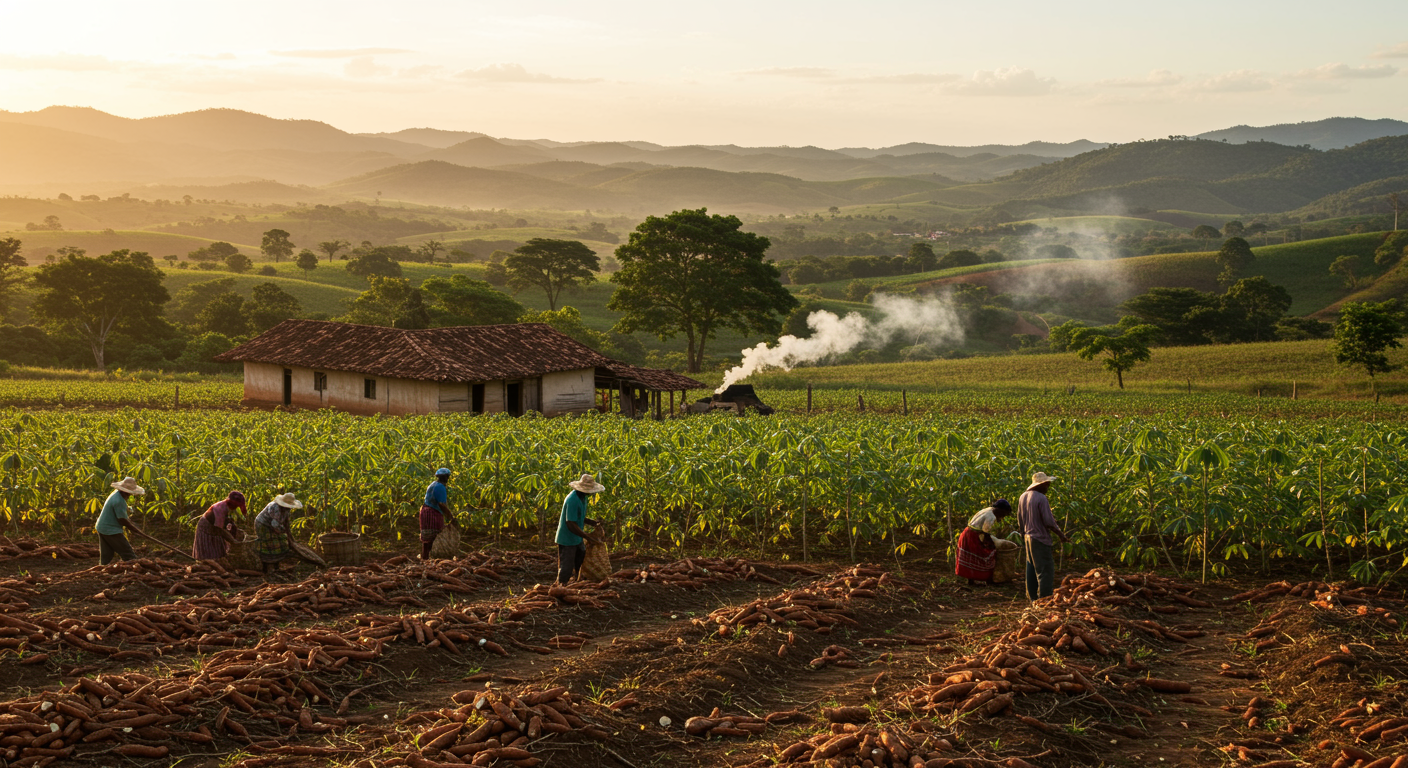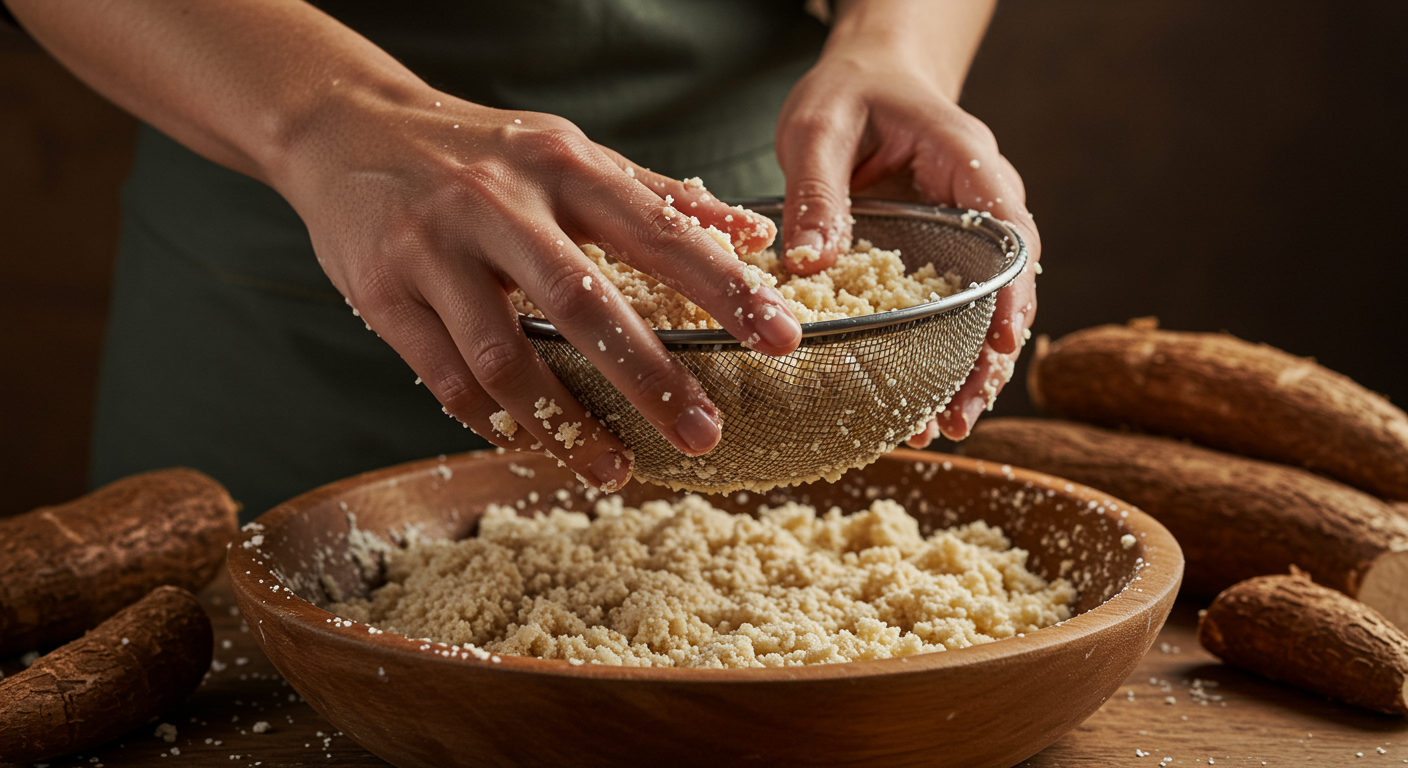Tapioca, a culinary marvel derived from cassava (known locally as mandioca), holds a place of profound significance in the vast culinary tapestry of Brazil, especially within the vibrant and culturally rich interior of Bahia. This isn’t merely a food item; it embodies centuries of history, representing a complex interplay of cultural exchange, ingenious adaptation, and the enduring resilience of various communities. To truly comprehend the essence of tapioca in this region, one must embark on a journey through its indigenous origins, its transformative evolution during colonial times, and its deep-rooted, almost sacred, presence in contemporary Bahian daily life. This exploration promises to unveil not only a delicious and versatile foodstuff but also a compelling narrative woven with threads of tradition, economic sustenance, and the very fabric of social existence.
Indigenous Origins and the Mastery of Cassava Cultivation
The narrative of tapioca indispensably commences with the indigenous peoples of Brazil, who were the original custodians and cultivators of mandioca, or cassava. This remarkable tuber served as an unparalleled foundational crop for these communities, offering a consistent and abundant source of essential carbohydrates across a multitude of diverse and often challenging ecosystems. Faced with the inherent complexities of processing, indigenous populations developed extraordinarily sophisticated and ingenious techniques to transform varieties of mandioca – particularly the bitter ones that contained potentially toxic hydrocyanic acid – into safely edible and remarkably versatile forms. Among their most pivotal innovations was the meticulous extraction and refinement of the starch, variously known as polvilho or goma, which constitutes the fundamental raw material from which tapioca is made.
The ancestral processing regimen typically involved a series of intricate steps: first, the cassava roots were laboriously grated, often using specialized wooden tools. Following this, the grated mass was subjected to intense pressing, meticulously designed to extract the liquid containing the harmful toxins. The remaining pulp was then carefully dried, and the starch, once thoroughly separated from the fibrous material and desiccated to perfection, could be stored for impressively extended periods. This capability provided a critical buffer against scarcity, offering invaluable food security to communities that depended heavily on seasonal harvests. This profound, ancient knowledge was not merely a matter of culinary technique; it was critical for survival, deeply intertwining with indigenous rituals, spiritual beliefs, and the rhythms of their daily existence. It stands as a powerful testament to an early form of advanced food technology, showcasing how raw, abundant natural resources could be thoughtfully transformed into a dietary cornerstone. The understanding of the plant’s properties and the development of safe processing methods highlight an unparalleled expertise in ethnobotany that predates European arrival by millennia.
Colonial Influence and the Dynamics of Adaptation
The arrival of Portuguese colonizers in the 16th century marked a pivotal turning point in the trajectory of tapioca. As Europeans navigated the new world, indigenous foodways, particularly the widespread utilization of mandioca, began an inevitable process of broader dissemination and integration. The Portuguese settlers, facing unfamiliar agricultural conditions and the difficulties of cultivating their traditional wheat in the tropical Brazilian climate, swiftly recognized the immense nutritional value and remarkable adaptability of cassava. Tapioca, in particular, rapidly ascended in popularity owing to its inherent ease of preparation and its exceptional versatility as a neutral base that could complement a myriad of flavors and ingredients.
Simultaneously, the tragically forced migration of enslaved African populations to Brazil introduced another profound layer of cultural and culinary influence. These communities, drawing upon their own rich gastronomic traditions, seamlessly integrated mandioca into their evolving culinary practices. They frequently combined existing indigenous methods with ingredients, techniques, and flavors from their African homelands, creating a vibrant culinary synthesis. This forced yet fertile cultural fusion not only enriched the pre-existing indigenous processing and preparation methods but also gave birth to novel preparations and distinctive flavors that continue to be profoundly influential and widely celebrated in Brazilian cuisine today. The interior of Bahia, by virtue of its historical importance as a nexus for both enduring indigenous presence and the significant influx of the transatlantic slave trade, emerged as a veritable crucible for these multifaceted culinary transformations, shaping tapioca into the diverse food item we know.
Evolution of Preparation Methods and Culinary Expansion
The earliest recorded forms of tapioca were inherently simpler, often serving as a rustic flatbread (beiju) or a nourishing porridge. However, as the colonial period progressed, and with greater access to diverse ingredients alongside burgeoning culinary creativity, the methodologies for preparing tapioca diversified significantly. The colonial kitchens, though often rudimentary, became laboratories of innovation. Basic tools were employed to process cassava starch, gradually giving rise to the various forms we now recognize, from tapioca pearls (sagu) to the iconic hydrated flatbreads. This era was also instrumental in fostering the emergence of distinct regional variations. Local resources, climactic conditions, and the evolving palate preferences of different communities meticulously shaped unique culinary identities for tapioca across the vast Brazilian territory, with Bahia standing out for its particular richness. The continuous experimentation with different levels of hydration, cooking temperatures, and post-cooking treatments contributed to an array of textures and forms, each suited to different culinary applications.
Tapioca in Bahian Culture: A Culinary Pillar and Cultural Symbol
In the deep interior of Bahia, the status of tapioca transcends mere sustenance; it is an intrinsic, almost spiritual, component of the region’s cultural identity and its daily rhythm. It is commonly enjoyed at breakfast, serving as a hearty and adaptable start to the day, as a quick and satisfying snack during the afternoon, or even as a light and comforting dinner. Its unparalleled versatility means it can be effortlessly paired with an astonishing array of sweet or savory fillings, thereby appealing to an incredibly broad spectrum of tastes and preferences across all demographics. From the warm, inviting hearths of humble family kitchens to the bustling, aromatic stalls of vibrant street food markets, tapioca maintains an undeniable and ubiquitous presence.
Its economic importance within the Bahian interior is equally profound and noteworthy. For myriad small-scale farmers, local producers, and family-run businesses, the cultivation of mandioca and the subsequent production of tapioca represent not just a source of livelihood but a vital, sustainable economic engine. This traditional agricultural activity plays a crucial role in sustaining local economies, providing employment, and, perhaps most importantly, preserving centuries-old practices and invaluable indigenous knowledge passed down through countless generations. The inherent value of tapioca in Bahia thus extends far beyond its basic caloric contribution, encompassing a rich historical legacy, the fundamental sustenance of communities, and an enduring sense of gastronomic pride that defines the region.
Regional Specificity and Unique Textural Characteristics
The geographic diversity and the complex tapestry of cultural influences converging within Bahia have inevitably given rise to specific and fascinating regional characteristics of tapioca. In certain micro-regions, the tapioca flatbread might be meticulously prepared to be exceptionally thin and remarkably crispy, offering a delightful textural contrast. Conversely, in other areas, a preference for a softer, more pliable, and sometimes chewier texture prevails, indicative of localized preparation techniques and consumer preferences. Furthermore, the fillings themselves are a direct reflection of the immediate local produce and the unique culinary traditions of each individual micro-region. This exquisite regional specificity adds yet more layers of depth and richness to the already extensive and profound Bahian tapioca culture, making each experience with tapioca a subtle discovery of local identity. The nuanced differences in starch quality, hydration levels, and cooking surfaces all contribute to these distinct regional profiles.
Table 1: Key Historical Milestones and Cultural Integration of Tapioca in Bahia
| Era | Key Developments & Cultural Integration | Broader Cultural & Economic Significance |
|---|---|---|
| Pre-Colonial | Cultivation of mandioca, pioneering of starch extraction by indigenous peoples. | Fundamental food security, deeply embedded in survival and spiritual rituals. |
| Colonial | Adoption by Portuguese, crucial integration into diets of enslaved Africans, initial flavor diversification. | Early culinary fusion, establishment as a fundamental staple, dietary adaptation. |
| Post-Colonial | Emergence of distinct regional variations, increased commercialization, widespread daily consumption. | Economic cornerstone for rural communities, evolving cultural symbol, gastronomic identity formation. |
| Modern Era | Rise of gourmet adaptations, recognition as a health food (gluten-free), sustained traditional production. | Culinary versatility, healthy lifestyle alternative, vital preservation of cultural heritage and economic sustainability. |
Traditional Preparations: A Spectrum of Bahian Flavors
The traditional preparation of tapioca in the interior of Bahia is a vivid testament to its remarkable adaptability and the culinary ingenuity of the region. The foundational method involves the careful spreading of hydrated cassava starch onto a preheated skillet or griddle, locally referred to as a tapiocaria or chapa. The precise application of heat causes the individual starch granules to rapidly agglutinate, forming a cohesive, flexible, and often subtly crispy flatbread. What follows this primary step is a captivating array of diverse fillings that fundamentally define its character and flavor profile.
Savory Tapioca: Hearty Staples of Bahian Cuisine
Savory tapioca stands as an indispensable cornerstone of Bahian cuisine, providing both sustenance and flavor. Common and highly cherished fillings include:
- Queijo Coalho (Grilled Halloumi-like Cheese): This combination is a timeless classic. The savory, often slightly salty, grilled cheese perfectly complements the neutral, delicate taste and soft texture of the tapioca. It is frequently served simply alone or with a delicate drizzle of molasses (melaço) for a touch of sweetness. The grilling process gives the cheese a distinct texture and flavor.
- Carne de Sol com Queijo (Sun-dried Beef with Cheese): A truly hearty and intensely flavorful option, this filling proudly showcases the region’s deep-seated agricultural traditions and artisanal meat preservation techniques. The tender, meticulously seasoned sun-dried beef, when paired with generous portions of melting cheese, creates an incredibly satisfying and robust meal, rich in texture and umami.
- Frango com Catupiry (Chicken with Cream Cheese): Representing a slightly more modern, yet universally popular, addition, this filling features shredded, well-seasoned chicken intimately mixed with Catupiry, a creamy, distinctively Brazilian cream cheese spread. The result is a comforting, rich, and deeply satisfying flavor profile.
- Ovos e Bacon (Eggs and Bacon): A quintessential breakfast favorite, this option provides a quick, convenient, and energy-rich start to the day. The simple combination of scrambled or fried eggs with crispy bacon offers a familiar and comforting taste within the tapioca’s embrace.
- Charque com Abóbora (Dried Beef with Pumpkin): A deeply traditional Bahian filling, combining the robust flavor of dried, salted beef (charque) with the sweet, earthy notes of cooked pumpkin. This blend showcases the harmonious use of local ingredients and reflects historical culinary practices, providing a balance of savory and subtly sweet.
Sweet Tapioca: Tropical Delights and Comforting Flavors
Sweet tapioca offers a delightful and refreshing contrast to its savory counterparts, frequently savored as a dessert, a comforting afternoon snack, or even a lighter breakfast option. Popular sweet fillings are often a celebration of tropical bounty:
- Coco Ralado com Leite Condensado (Shredded Coconut with Condensed Milk): This simple yet incredibly popular combination epitomizes tropical indulgence. The fragrant, fresh shredded coconut, generously sweetened with creamy condensed milk, creates a rich and deeply satisfying flavor that evokes the essence of Bahia’s coastal and interior landscapes.
- Banana com Canela (Banana with Cinnamon): A wholesome, naturally sweet, and aromatic choice, slices of ripe banana are often lightly fried or gently grilled directly within the tapioca, then dusted with fragrant cinnamon. This creates a warm, comforting, and nutritious filling.
- Goiabada com Queijo (Guava Paste with Cheese): This classic “Romeo e Julieta” combination is a beloved Brazilian staple. The intensely sweet and tangy guava paste, when paired with a mild, often slightly salty, cheese (like queijo minas or a soft fresh cheese), creates a harmonious and addictive balance of flavors. This pairing is a profound testament to the versatility and creativity of combining seemingly disparate sweet and savory elements in Brazilian cuisine.
- Chocolate com Morango (Chocolate with Strawberry): A more contemporary and universally appealing sweet filling, featuring melted chocolate (often bittersweet or milk chocolate) combined with fresh, sliced strawberries. This offers a delightful blend of rich, decadent sweetness and tart fruitiness, appealing to a broader, modern palate.
Beyond the Pan: Expanded Forms and Culinary Innovations of Tapioca
While the flatbread (beiju) remains the most iconic and recognizable form, tapioca starch is remarkably versatile and is also utilized in numerous other traditional and evolving Bahian preparations:
- Beiju: While often synonymous with tapioca flatbread, Beiju can refer to thinner, sometimes crispier versions, or those molded into specific shapes, reflecting distinct regional styles. It highlights the raw simplicity and versatility of the starch.
- Bolo de Tapioca (Tapioca Cake): This is typically a no-bake cake, a creamy and textural marvel made by hydrating tapioca granules with coconut milk and often enriched with condensed milk. It’s then allowed to set in a refrigerator, resulting in a rich, subtly textured, and refreshing dessert that is a staple in many Bahian households and celebrations. The granules swell and soften, creating a unique consistency.
- Dadinhos de Tapioca (Tapioca Cubes): While the exact origin is debated, these small, crispy cubes made from tapioca, cheese (often queijo coalho), and milk have become a beloved modern Brazilian appetizer. Typically deep-fried until golden and served with a sweet chili dipping sauce, they showcase tapioca’s ability to transform into a savory, texturally exciting snack, a testament to culinary innovation blending traditional ingredients with contemporary techniques.
- Pudim de Tapioca (Tapioca Pudding): A classic Brazilian dessert, this creamy pudding incorporates tapioca pearls or granules, often generously enriched with coconut milk, eggs, and sugar. It can be baked or steamed, resulting in a rich, comforting, and deeply satisfying sweet treat that exemplifies the use of tapioca in more elaborate dessert forms, showcasing its gelatinous properties for texture.
- Mingau de Tapioca (Tapioca Porridge): A comforting and nourishing hot porridge, especially popular for breakfast or as a light meal. It’s made by cooking tapioca pearls or fine granules in milk (often coconut milk), sugar, and sometimes cinnamon or cloves. It offers a warm, creamy texture and can be customized with various toppings.
- Pirão de Mandioca: While typically made with cassava flour, the underlying principle of thickening with a cassava derivative is similar. Pirão is a thick, creamy sauce or condiment often served with fish stews (moquecas) or other hearty dishes. In some Bahian contexts, tapioca flour might be used to achieve a lighter texture. It highlights the pervasive use of mandioca in various forms to add body and flavor to dishes.
Table 2: Diverse Tapioca Preparations and Their Culinary Role
| Preparation Type | Primary Characteristics | Flavor Profile | Cultural/Serving Context |
|---|---|---|---|
| Flatbread (Beiju/Tapioca) | Cooked starch on griddle, versatile fillings. | Neutral base, takes on filling flavor. | Daily staple (breakfast/snack), street food. |
| Bolo de Tapioca | No-bake cake, hydrated granules, coconut milk, condensed milk. | Sweet, creamy, subtly textured. | Desserts, festive occasions, family gatherings. |
| Dadinhos de Tapioca | Fried cubes of tapioca and cheese. | Savory, crispy exterior, soft interior. | Appetizer, modern snack, social events. |
| Pudim de Tapioca | Baked/steamed pudding, tapioca pearls/granules, coconut milk. | Sweet, rich, creamy. | Desserts, special treats. |
| Mingau de Tapioca | Hot porridge, tapioca pearls/granules cooked in milk. | Sweet, warm, comforting. | Breakfast, light meal, comfort food. |
The Enduring Cultural Significance in Modern Bahia
In the contemporary landscape of Bahia, tapioca continues to flourish, maintaining its status as a vital cultural icon, particularly robustly in its interior. Its sustained prominence represents an unbroken chain of continuity with ancestral traditions, a tangible connection to the fertile land through the cultivation of mandioca, and a joyful celebration of the region’s unique and vibrant flavors. The very act of preparing tapioca often transcends a mere cooking task; it frequently involves communal activity, the cherished sharing of treasured family recipes, and the telling of stories, all of which powerfully reinforce social bonds and cultural identity. For countless Bahians, tapioca is more than just food; it deeply evokes profound memories of home, childhood, and the simple, authentic pleasures of life.
Furthermore, the global surge in interest surrounding healthy eating and the increasing demand for gluten-free alternatives have strategically positioned tapioca for a significant resurgence in broader Brazilian and even international markets. This trend has introduced tapioca to new audiences and applications. However, it is crucial to note that in Bahia, its status as a beloved, indispensable staple food has never wavered. The traditional methods of cultivation and preparation, the authentic, unadulterated flavors, and the rich cultural narratives that lovingly surround tapioca remain remarkably robust and resilient. This ensures its indelible place as a cherished culinary icon, a testament to its enduring appeal and profound cultural impact nestled deeply within the heart of Bahia. Its incredible journey from an indigenous staple to a colonial adaptation, and finally to a modern culinary delight, powerfully underscores its timeless appeal and its unwavering cultural significance.

